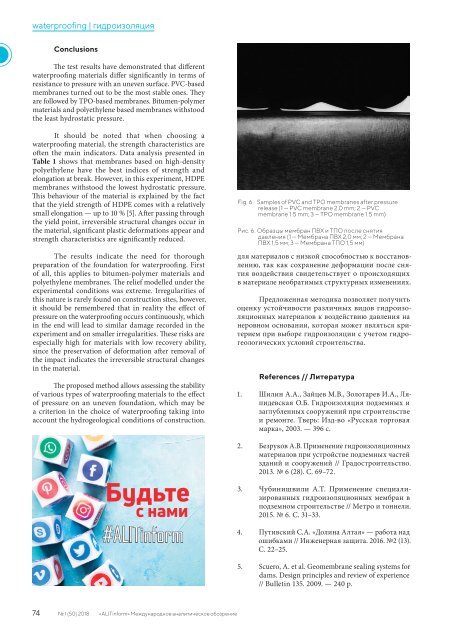AlitInform 50
“ALITinform” is a periodical that covers different aspects in production and applications of cement, concrete, and dry building mixtures. Pages of this journal offer contributions from leading Russian and International scientists, technologists and leading professionals, news from the stock markets, research laboratories, latest elaborations by producers and suppliers of modern building materials and equipment. The magazine goal is to unite on its pages the articles of the leading Russian and International specialists in the field of cement, concrete, dry building mixtures; latest news of the Russian and world building materials market, the traditions of peer-reviewed Russian scientific magazines and innovative informational approach of the contemporary printed media. The prime focus is on developments serving the purpose of rationalization of production, reduction of energy consumption, enhancement of quality and improvement of environmental safety. _______________________________________
“ALITinform” is a periodical that covers different aspects in production and applications of cement, concrete, and dry building mixtures. Pages of this journal offer contributions from leading Russian and International scientists, technologists and leading professionals, news from the stock markets, research laboratories, latest elaborations by producers and suppliers of modern building materials and equipment.
The magazine goal is to unite on its pages the articles of the leading Russian and International specialists in the field of cement, concrete, dry building mixtures; latest news of the Russian and world building materials market, the traditions of peer-reviewed Russian scientific magazines and innovative informational approach of the contemporary printed media. The prime focus is on developments serving the purpose of rationalization of production, reduction of energy consumption, enhancement of quality and improvement of environmental safety.
_______________________________________
You also want an ePaper? Increase the reach of your titles
YUMPU automatically turns print PDFs into web optimized ePapers that Google loves.
waterproofing | гидроизоляция<br />
Conclusions<br />
The test results have demonstrated that different<br />
waterproofing materials differ significantly in terms of<br />
resistance to pressure with an uneven surface. PVC-based<br />
membranes turned out to be the most stable ones. They<br />
are followed by TPO-based membranes. Bitumen-polymer<br />
materials and polyethylene based membranes withstood<br />
the least hydrostatic pressure.<br />
It should be noted that when choosing a<br />
waterproofing material, the strength characteristics are<br />
often the main indicators. Data analysis presented in<br />
Table 1 shows that membranes based on high-density<br />
polyethylene have the best indices of strength and<br />
elongation at break. However, in this experiment, HDPE<br />
membranes withstood the lowest hydrostatic pressure.<br />
This behaviour of the material is explained by the fact<br />
that the yield strength of HDPE comes with a relatively<br />
small elongation — up to 10 % [5]. After passing through<br />
the yield point, irreversible structural changes occur in<br />
the material, significant plastic deformations appear and<br />
strength characteristics are significantly reduced.<br />
The results indicate the need for thorough<br />
preparation of the foundation for waterproofing. First<br />
of all, this applies to bitumen-polymer materials and<br />
polyethylene membranes. The relief modelled under the<br />
experimental conditions was extreme. Irregularities of<br />
this nature is rarely found on construction sites, however,<br />
it should be remembered that in reality the effect of<br />
pressure on the waterproofing occurs continuously, which<br />
in the end will lead to similar damage recorded in the<br />
experiment and on smaller irregularities. These risks are<br />
especially high for materials with low recovery ability,<br />
since the preservation of deformation after removal of<br />
the impact indicates the irreversible structural changes<br />
in the material.<br />
The proposed method allows assessing the stability<br />
of various types of waterproofing materials to the effect<br />
of pressure on an uneven foundation, which may be<br />
a criterion in the choice of waterproofing taking into<br />
account the hydrogeological conditions of construction.<br />
Будьте<br />
с нами<br />
#ALITinform<br />
Fig. 6. Samples of PVC and TPO membranes after pressure<br />
release (1 — PVC membrane 2.0 mm; 2 — PVC<br />
membrane 1.5 mm; 3 — TPO membrane 1.5 mm)<br />
Рис. 6. Образцы мембран ПВХ и ТПО после снятия<br />
давления (1 — Мембрана ПВХ 2,0 мм; 2 — Мембрана<br />
ПВХ 1,5 мм; 3 — Мембрана ТПО 1,5 мм)<br />
для материалов с низкой способностью к восстановлению,<br />
так как сохранение деформации после снятия<br />
воздействия свидетельствует о происходящих<br />
в материале необратимых структурных изменениях.<br />
Предложенная методика позволяет получить<br />
оценку устойчивости различных видов гидроизоляционных<br />
материалов к воздействию давления на<br />
неровном основании, которая может являться критерием<br />
при выборе гидроизоляции с учетом гидрогеологических<br />
условий строительства.<br />
References // Литература<br />
1. Шилин А.А., Зайцев М.В., Золотарев И.А., Ляпидевская<br />
О.Б. Гидроизоляция подземных и<br />
заглубленных сооружений при строительстве<br />
и ремонте. Тверь: Изд-во «Русская торговая<br />
марка», 2003. — 396 с.<br />
2. Безруков А.В. Применение гидроизоляционных<br />
материалов при устройстве подземных частей<br />
зданий и сооружений // Градостроительство.<br />
2013. № 6 (28). С. 69–72.<br />
3. Чубинишвили А.Т. Применение специализированных<br />
гидроизоляционных мембран в<br />
подземном строительстве // Метро и тоннели.<br />
2015. № 6. С. 31–33.<br />
4. Путивский С.А. «Долина Алтая» — работа над<br />
ошибками // Инженерная защита. 2016. №2 (13).<br />
С. 22–25.<br />
5. Scuero, A. et al. Geomembrane sealing systems for<br />
dams. Design principles and review of experience<br />
// Bulletin 135. 2009. — 240 p.<br />
74 № 1 (<strong>50</strong>) 2018 «ALITinform» Международное аналитическое обозрение



